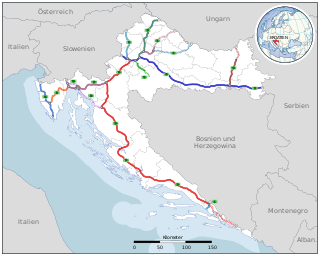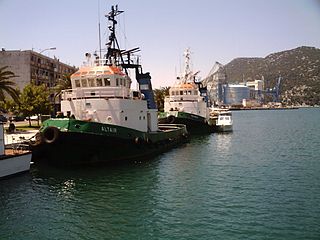
The economy of Croatia is a developed mixed economy. It is one of the largest economies in Southeast Europe by nominal gross domestic product (GDP). It is an open economy with accommodative foreign policy, highly dependent on international trade in Europe. Within Croatia, economic development varies among its counties, with strongest growth in Central Croatia and its financial centre, Zagreb. It has a very high level of human development, low levels of income inequality, and a high quality of life. Croatia's labor market has been perennially inefficient, with inconsistent business standards as well as ineffective corporate and income tax policy.

Transport in Croatia relies on several main modes, including transport by car, train, ship and plane. Road transport incorporates a comprehensive network of state, county and local routes augmented by a network of highways for long-distance travelling. Water transport can be divided into sea, based on the ports of Rijeka, Ploče, Split and Zadar, and river transport, based on Sava, Danube and, to a lesser extent, Drava. Croatia has 9 international airports and several airlines, of which the most notable are Croatia Airlines and Trade Air. Rail network is fairly developed but regarding inter-city transport, bus tends to be far more common than the rail.

Krk is a Croatian island in the northern Adriatic Sea, located near Rijeka in the Bay of Kvarner and part of Primorje-Gorski Kotar county. Krk is tied with Cres as the largest Adriatic island, depending on the methodology used to measure the coastline. Krk is the most populous island in the Adriatic, with multiple towns and villages that contain a total of 19,916 (2021) inhabitants.

Omišalj is a coastal municipality in the north-west of the island of Krk in Croatia. The population of Omišalj itself is 1,887 (2021), while the municipality also includes the nearby village of Njivice, bringing the total population to 2,992. Omišalj is best known in modern times for hosting the Rijeka Airport as well as Port of Rijeka oil terminal.

The Druzhba pipeline ; also has been referred to as the Friendship Pipeline and the Comecon Pipeline) is one of the world's longest oil pipelines and one of the largest oil pipeline networks in the world. It began operation in 1964 and remains in operation today. It carries oil some 4,000 kilometres (2,500 mi) from the eastern part of European Russia to points in Ukraine, Belarus, Poland, Hungary, Slovakia, the Czech Republic and Germany. The network also branches out into numerous smaller pipelines to deliver its product throughout Eastern Europe and beyond.

The Louisiana Offshore Oil Port (LOOP) is a deepwater port in the Gulf of Mexico 29 kilometers off the coast of Louisiana near the town of Port Fourchon. LOOP provides tanker offloading and temporary storage services for crude oil transported on some of the largest tankers in the world. Most tankers offloading at LOOP are too large for U.S. inland ports. LOOP handles 13 percent of the nation's foreign oil, about 1.2 million barrels (190,000 m3) a day, and connects by pipeline to 50 percent of the U.S. refining capability.

Stanlow Refinery is an oil refinery owned by Essar Energy in Ellesmere Port, North West England. Until 2011, it was owned by Shell UK. The refinery is situated on the south bank of the Manchester Ship Canal, which is used to transport seaborne oil for refining and chemicals for Essar.

The Caspian Pipeline Consortium (CPC) is a consortium and an oil pipeline that transports Caspian oil from the Tengiz oil field in Kazakhstan to the Novorossiysk-2 Marine Terminal, an export terminal at the Russian Black Sea port of Novorossiysk. It is one of the world's largest pipelines and a major export route for oil from the Kashagan and Karachaganak fields. The CPC pipeline transfers about 1% of global oil supply and handles almost all of Kazakhstan's oil exports. In 2021, the pipeline exported up to 1.3 million barrels per day (bpd) of Kazakhstan's main crude grade, light sour CPC Blend, which represented 80% of Kazakhstan's total oil production of 1.6 million bpd.

Croatian Littoral is a historical name for the region of Croatia comprising mostly the coastal areas between traditional Dalmatia to the south, Mountainous Croatia to the north, Istria and the Kvarner Gulf of the Adriatic Sea to the west. The term "Croatian Littoral" developed in the 18th and 19th centuries, reflecting the complex development of Croatia in historical and geographical terms.

The Pan-European Oil Pipeline (PEOP) is a proposed oil pipeline from Constanţa in Romania via Serbia and Croatia to Rijeka and from there through Slovenia to Trieste in Italy. The aim of the pipeline is to bypass Turkish straits in the transportation of Russian and Caspian oil to Central Europe. In Trieste the pipeline will be connected with the Transalpine Pipeline, running to Austria and Germany.
INA-Industrija nafte, d.d. is a Croatian multinational oil company. INA Group has leading role in Croatia's oil business, a strong regional position in the oil and gas exploration and production, oil processing, and oil product distribution activities. INA, d.d. is a stock company with the Hungarian MOL Group and the Croatian Government as its biggest shareholders, while a minority of shares is owned by private and institutional investors. INA shares have been listed at the London and Zagreb stock exchanges since December 1, 2006. INA Group is composed of several affiliated companies wholly or partially owned by INA, d.d.. The Group has its headquarters in Zagreb.
LNG Hrvatska d.o.o. is a company that operates a floating liquefied natural gas (LNG) regasification terminal in Omišalj on the island of Krk, Croatia. It commenced operations on 1 January 2021, with full capacity booked for the next three years.

Adria oil pipeline is a crude oil pipeline in Croatia, Serbia, and Hungary with branch lines to Slovenia and Bosnia and Herzegovina.

The Port of Split is a port in the central Dalmatian city of Split, Croatia. The port was originally a trading post originally established by Greek settlers from the island of Vis and subsequently taken over by the Romans. The port thrived through the Middle Ages, but it suffered a decline in the late 18th and early 19th centuries when the Port of Rijeka took over as the primary trading and shipping outlet of the region. The decline was also attributed to the decline of the Ottoman Empire, a traditional market for the Port of Split, and the growing domination of Austrian Empire.

The Port of Ploče is a seaport in Ploče, Croatia, near the mouth of the Neretva river on the Adriatic Sea coast. It was formally opened in 1945 after a railway was built as a supply route to connect the site with industrial facilities in the Sarajevo and Mostar areas of Bosnia and Herzegovina, which was then part of Yugoslavia. As of 2010, it ranked as the second largest cargo port in Croatia—after the Port of Rijeka—with a cargo throughput of 4.5 million tonnes, consisting mostly of general cargo and bulk cargo, including 20,420 TEU Containers. In 2008, the Port of Ploče recorded 2,555 ship arrivals. It is managed by the Port of Ploče Authority.
The Port of Rijeka is a seaport in Rijeka, Croatia, located on the shore of the Kvarner Gulf in the Adriatic Sea. The first records of the port date to 1281. It was the main port of the Kingdom of Hungary in the 19th century and the beginning of the 20th century, of Yugoslavia between World War II and 1991, and of Croatia after its independence. Today, it is the largest port in Croatia with a cargo throughput of 13.6 million tonnes (2020), mostly oil, general cargo and bulk cargo, and 344,091 Twenty-foot equivalent units (TEUs).
Luka Rijeka is a Croatian port operating company which operates port facilities at the largest Croatian Port of Rijeka and several other terminals nearby. In 2020, Luka Rijeka d.d., a concessionaire of the Port of Rijeka reported net profit of 3.321 million kuna, while total income in 2020 reached 167.75 million kuna. In 2020, the company had 635 employees. Share capital of the company is 539 million kuna, and it is listed at the Zagreb Stock Exchange. Since 2020, chairman of the board of the company is Duško Grabovac.
Dalekovod d.d. is a Croatian company, active in electrical engineering and civil engineering sectors. Its primary activities comprise design, production and construction of electrical power structures, electrical substations, power transmission mains, telecommunications structures, road equipment, railway equipment and street lighting. In 2010, net income of the company was 4.7 million kuna, exhibiting a decrease from 110.9 million kuna net income reported for 2009. At the end of the 2010, the company employed 1424 persons. Dalekovod was founded in 1949 as a state owned company, and restructured as a joint stock company in 1993 and subsequently listed at the Zagreb Stock Exchange. It is one of 24 companies included in the CROBEX share index. As of August 2011, head of the company is Luka Miličić. Recently the company has declared its plans to expand in the energy development sector, especially in the field of renewable energy. In 2012, Dalekovod plans to invest into and build a wind farm near Benkovac and Obrovac.
Energy in Serbia is dominated by fossil fuels, despite the public preference for renewable energy.











